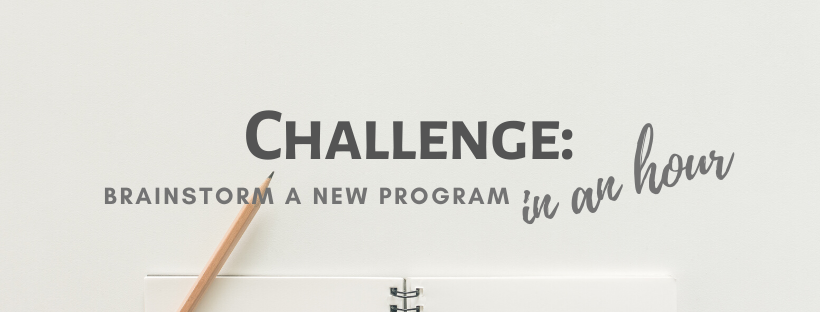While I was writing Brainstorm Central: 15 Concepts and 50 Components and listing out a few Christmas phrases one could use as starter inspiration, I got annoyed with myself. As is often the result, I had a Smeagol-Gollum type chat with myself (internally, thankfully, as I was in a busy coffee shop at the time) that went something like this:
“You’re just spouting off random phrases that sound like Christmas.”
“No, these are actual terms directly from the Bible, or a longstanding Christmas hymn. They’re immediately recognizable and carry a lot of inspirational weight.“
“How can you expect a person to write anything meaningful, with just a few words?”
“It’s not that hard- you just see what songs and Scripture matches up with the concept, and put them into a logical sequence. It’s the fleshing it out later that is the difficult part.”
“You’re just making your reader do all the work – how are you even helping anyone?”
“Fine then. I’ll write up a pattern for how I’d take this from concept to a workable outline. Satisfied?”
“Only if you pick a concept you haven’t produced before. No fair to reverse engineer from a completed script.”

I picked “Fear Not” (what the angel says to Mary) and brainstormed for just over an hour. And here’s what I came up with:
Search the Scripture
Always a good place to start.
I did some searching with an online concordance. (Who am I kidding: I went to Google and found blog posts compiling verses about fear). Someone wrote that there are about/at least 80 commands in Scripture NOT to fear…and I asked myself:
Why are we commanded to “Fear not”:
- God promises that He has overcome the world (John 16:33)
- God says He has redeemed us and called us His own (Isaiah 43:1)
- God says He is with us (Isaiah 41:10)
So we see that God is all-powerful, He’s claimed us as His own, and He promises to be with us and give us His peace.
Looking for music
You’re putting together a rough list of songs that “might” fit. You’re not looking for perfect fits; this is a process!
Part 1: Search YouTube & Google for songs that reference your keyword theme, whether or not they’re technically Christmas songs.
Here’s what I found in my brainstorming session:
Fear Not (Point of Grace)
I Heard the Bells on Christmas Day (Casting Crowns)
Part 2: Look for any songs that quote the specific Scriptures you’ve found. In this case, since one reason we have not to fear is “God is with us”, we can also search for songs that reference “Emmanuel.”
Emmanuel (Michael W. Smith)
Build a progression of thought
What concepts naturally follow each other? One pattern is: story opens – doctrine – reflection – story closes – application, such as the following:
- Story opens: Mary’s legitimate fear & the angel’s command to “Fear not”.
- Doctrine: Exploration of Biblical commands not to fear (whether read from Scripture or sung), and the reasons given in those commands.
- Reflection: Reflection on God’s character.
- Story closes: Mary’s response in Luke 1:38 – “I am the servant of the Lord; let it be to me according to your word.”
- Application: Expression of what our response should be – fear into faith.
Here is where the brainstorming session itself ended, but I mapped out what I’d do next:
Structuring the program
Determine what key points will be emphasized, and what concepts might be subsections or just references. Decide how long to allow for each section. Consider if any additional themes should be developed in parallel (say, “God with us” is very relevant both to the Christmas story and the overall theme).
Themes don’t have to be heavy-handed. Light and subtle is still powerful; it gives the main thought precedence while allowing for depth and complexity. ***This is important: new churchgoers & unbelieving visitors will grasp the main concept without too much being thrown at them, and longtime believers will pick up on a new dimension they might not have reflected on.***
Choose your production elements
A costumed Mary giving two separate monologues? A sermon explaining the doctrine and reflection, or several readers narrating a script you’ll write? What points do you want to highlight with music? (see the 40+ elements you can use for various effects)
Decide on the music
Collecting a body of music that “might” relate to the theme is very helpful at the beginning of the process to inspire you. Now is the time to cull out the extra and just keep what really fits well.
Search out new songs that add depth for the points you want to emphasize. The section on Mary’s response is a perfect time to include a song; perhaps the Getty arrangement of “Magnificat”, or Amy Grant’s “Breath of Heaven”.
And you’re well on your way to a full, fleshed out, cohesive and powerful script, just from two words!
Pushing a timeframe wasn’t so much about seeing how much content I could come up with in a short amount of time. It was more to give a deadline that forced me to distill the process from “hours of Googling in coffee shops” into a short, logical checklist:
- Search the Scripture
- Look for music options
- Build a progression of thought
- Structure the program
- Choose production elements

